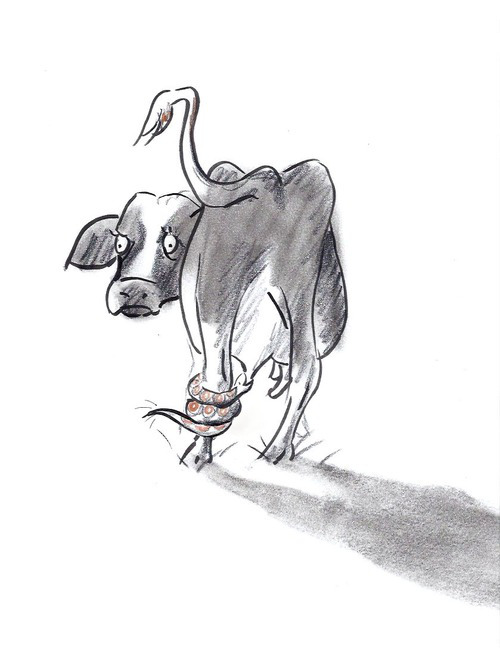Milk Stealers: Paleolithic or Neolithic? November 21, 2016
Author: Beach Combing | in : Ancient, Prehistoric , trackback
It is a snakey week and here is a second snake post in almost as many days. There are many legends about snakes and other reptiles taking milk from nursing mothers, there are also many legends about snakes and other reptiles (and sometimes birds) taking milk from cattle. Beach has given examples of these tales on a number of occasions and these must almost certainly be associations with the notorious bosom serpent: the snake that takes up residence in a man or woman’s stomach. However, something that recently struck Beach was how, well, fundamentally different the legends about women’s breasts and the legends about cattle should be.
Breast-feeding is, of course, archaic and universal: the earliest humans (and their hominid ancestors) breast-fed and this was, of course, true anywhere. There were no aristocratic neanderthals who opted out. However, not all human communities milked animals. Northern Europe and North-Eastern Africa were the two centres of milking with predictable consequences for lactose tolerance there: and even these places have only milked for five or six thousand years. Other areas of the world milked to a lesser degree: e.g. the Arab world. Still, other areas of the world, e.g. the Americas (where there were no domesticated animals, other than llamas) and China had little or no access to milk. So how do legends of milk stealers play out in these places?
Well, Beach should first make the obvious point that there is no, or very little written evidence for the Americas before 1500: at least which survives. There is art work, which of course is full of ambiguities. In other words it is impossible to confidently answer the question of whether milk-stealing legends in the Americas predate Columbus and the introduction of domestic animals by Europeans. However, from what Beach can understand there seems to be no east Asian evidence of milk stealers (breast or udder): while there is plenty of East Asian evidence for bosom serpents: bosom serpents really do seem to be universal.
What does all this mean? Well, let’s assume for a minute that this is real: in other words that this is not just a problem of the irregular survival of written sources. It could be taken to mean that the milk-stealing legend begins with udders and is only later transferred to breasts. In that case the fear about snakes and milk is likely not Paleolithic but late Neolithic in origin: these legends are so widespread that it would be absurd to date them simply to the first written records in antiquity. Of course, there are other possibilities. It may be that milk-stealing legends began with anxieties about human breasts, but that this was not everywhere expressed by fears about animals actually approaching the nursing mother. Still…
Any views: drbeachcombing At yahoo DOT com
27/11/2016 Beach himself writes: ‘This is new to me but one twitter follower, whose twitter account I cannot now find, sorry, pointed out the activity called milk stealing. Young mammals are killed and partly digested milk is eaten from their stomach. Completely new to me! Worth stating that from the Neolithic Revolution onwards there were animals to milk in Euroasia and Africa, it was just that people chose not to, presumably because of intolerance’
Leif writes, 8 Dec 2016: A correction to your Milk Stealers entry of 21 November 2016, where you state: ‘Still, other areas of the world, e.g. the Americas (where there were no domesticated animals, other than llamas)…’ Pre-Columbian Americans domesticated a number of species, including dogs [1], turkeys [2], and guinea pigs [3]. The Indians had other domestic species as well– Pizarro found chickens in the Incan Empire of the 1520s, though these fowl were brought over from Polynesia at some point. Two additional things: The correction has little bearing on your thesis, and my second source appears in your History roundup 742 of 28 November 2016. (Funny how these things turn up.)
[1] van Asch, Barbara, et. al. Pre-Columbian origins of Native American dog breeds, with only limited replacement by European dogs, confirmed by mtDNA analysis. Proceedings of the Royal Society B. Published 10 July 2013.
http://rspb.royalsocietypublishing.org/content/280/1766/20131142
[2] St. Fluer, Nicholas. Thanksgiving Turkeys May Have Been Tamed 1,500 Years Ago in Mexico. The New York Times. 23 Nov 2016. http://www.nytimes.com/2016/11/23/science/turkey-domestication-mexico.html?smid=tw-nytimesscience&smtyp=cur&_r=0
[3] Forstadt, Michael S. History of the Guinea Pig (Cavia porcellus) in South America: a summary of the current state of knowledge. http://cavyhistory.tripod.com/


